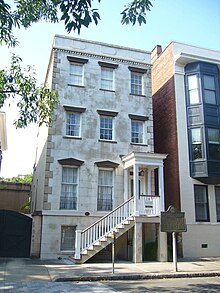Lafayette Square is one of the 22 squares of Savannah, Georgia, United States. It is located in the fourth row of the city's five rows of squares, on Abercorn Street and East Macon Street, and was laid out in 1837. It is south of Colonial Park Cemetery, west of Troup Square, north of Taylor Square and east of Madison Square. The square is named for Gilbert du Motier, Marquis de Lafayette, the French hero of the American Revolution who visited Savannah in 1825. The oldest building on the square is the Andrew Low House, at 329 Abercorn Street, which dates to 1849.[1]
 Flannery O'Connor's childhood home stands in the southeastern tything lot of the square | |
| Namesake | Gilbert du Motier, Marquis de Lafayette |
|---|---|
| Maintained by | City of Savannah |
| Location | Savannah, Georgia, U.S. |
| Coordinates | 32°04′23″N 81°05′30″W / 32.0730°N 81.0917°W |
| North | Abercorn Street |
| East | East Macon Street |
| South | Abercorn Street |
| West | East Macon Street |
| Construction | |
| Completion | 1837 |
The square contains a fountain commemorating the 250th anniversary of the founding of the Georgia colony, donated by the Colonial Dames of Georgia in 1984, as well as cobblestone sidewalks.[2][3][4]
Adjacent to the square is the Roman Catholic Cathedral Basilica of St. John the Baptist. Given this proximity, Lafayette Square features prominently in Savannah's Saint Patrick's Day celebrations. Water in the fountain is dyed green for the occasion.[5]
In this area is the museum known as the Flannery O'Connor Childhood Home, which is open to the public.
Dedication
edit| Namesake | Image | Note |
|---|---|---|
| Gilbert du Motier, Marquis de Lafayette | The square is named for Gilbert du Motier, Marquis de Lafayette (1757–1834), French aristocrat and military officer who fought in the American Revolutionary War. |
Markers and structures
edit| Object | Image | Note |
|---|---|---|
| Fountain | The square's fountain, looking south to the former site of the Marist School at today's 123 East Charlton Street | |
| Fountain | A video of the fountain. |
Constituent buildings
editEach building below is in one of the eight blocks around the square composed of four residential "tything" blocks and four civic ("trust") blocks, now known as the Oglethorpe Plan. They are listed with construction years where known.
- Northwestern residential/tything lot
- 104 East Harris Street (1875)[1]
- Centurian House, 106 East Harris Street (1903)[1]
- 118 and 124 East Harris Street (1852)[1]
- 319 Abercorn Street (1888)[1]
- Henrietta Cohen Property, 312–314 Drayton Street (1882)[1]
- Southwestern civic/trust lot
- Andrew Low House, 329 Abercorn Street (1849)[1] – part of the Juliette Gordon Low Historic District; oldest building on the square
- Andrew Low Carriage House, 330 Drayton Street (1849)[1] – part of the Juliette Gordon Low Historic District
- Southwestern residential/tything lot
- Marist Place, 123 East Charlton Street – former site of the Marist School
- Battersby–Hartridge–Anderson House, 119 East Charlton Street (1852)[1]
- Northeastern residential/tything lot
- Cathedral Basilica of St. John the Baptist, 222 East Harris Street (1876) – spires added in 1896
- Southeastern civic/trust lot
- Hamilton–Turner Inn, 330 Abercorn Street (1873)[1]
- Southeastern residential/tything lot
- Fitzgerald Pelot Duplex, 221–223 East Charlton Street (1854–1855)[1]
- Catherine McMahon House, 211 East Charlton Street (1853)[1]
- Flannery O'Connor Childhood Home, 207 East Charlton Street (1856)[1]
- John B. Gallie House, 201–203 East Charlton Street (1858)[1]
- 340 Abercorn Street (1903)
The Octavius Cohen House, built in 1848, formerly stood at 327 Abercorn Street. It was demolished to make way for today's Lafayette Condominiums,[6] once owned by Joe Odom.[7]
Gallery
edit-
Cathedral Basilica of St. John the Baptist, 222 East Harris Street
-
Hamilton-Turner Inn, 330 Abercorn Street
-
Battersby–Hartridge–Anderson House, 119 East Charlton Street
-
Marist Place, 123 East Charlton Street
-
Catherine McMahon House, 211 East Charlton Street
-
Fitzgerald Pelot Duplex, 221–223 East Charlton Street
-
Andrew Low Carriage House, 330 Drayton Street
-
319 Abercorn Street
-
Henrietta Cohen Property, 312–314 Drayton Street
-
340 Abercorn Street
-
104 East Harris Street
-
Centurian House, 106 East Harris Street
-
118 and 124 East Harris Street
-
John B. Gallie House, 201–203 East Charlton Street
References
edit- ^ a b c d e f g h i j k l m n Historic Building Map: Savannah Historic District – Historic Preservation Department of the Chatham County-Savannah Metropolitan Planning Commission (November 17, 2011), p. 51
- ^ See Savannah by T.D. Conner (2001), accessed June 14, 2007
- ^ Savannah Scene Archived 2008-11-03 at the Wayback Machine magazine, May–June 2007, pp 10–11, accessed June 16, 2007.
- ^ City of Savannah's monuments page Archived 2016-03-03 at the Wayback Machine This page links directly to numerous short entries, many accompanied by photographs, discussing a variety of monuments, memorials, etc., in the squares and elsewhere. Accessed June 16, 2007.
- ^ Chan Sieg (1984). The squares: an introduction to Savannah. Virginia Beach: Donning.
- ^ Spracher, Luciana M. (2003). Lost Savannah: Photographs from the Collection of the Georgia Historical Society. Arcadia Publishing. p. 30. ISBN 978-0-7385-1487-1.
- ^ Porter, Darwin; Prince, Danforth (1998-04-17). Frommer's Portable Charleston & Savannah. Wiley. ISBN 978-0-02-862445-7.